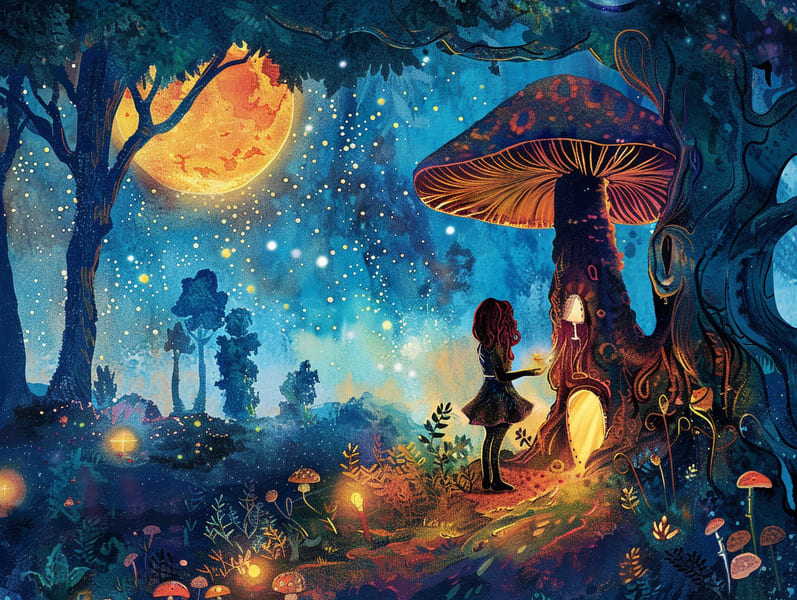The Evolution of Bedtime Fairy Tales and Their Eternal Loveliness.
The Evolution of Bedtime Fairy Tales and Their Eternal Loveliness.
Blog Article

Short fairy tales have timeless appeal. These narratives have been told from one generation to the next long before they were ever published. They arose from a variety of cultures, including European traditions. They were initially transmitted among grown-ups, often carrying themes and messages relevant to the societal norms and beliefs of the time.
The renowned Brothers Grimm, Jacob and Wilhelm (the Grimm brothers), were among the first to assemble many of these beloved narratives. Their anthology, "Grimm's Fairy Tales," included classics like "The True Bride," "Hansel and Gretel," and "Snow-White and Rose-Red," which have since become classics in the world of children's fairy tales. Similarly, Andersen's fanciful fairy tales, such as "The Mermaid," and "The Little Duckling," have won hearts worldwide, cementing their place in the pantheon of famous fairy tales.
Despite their historical roots, traditional fairy tales remain as impactful as ever, especially as kids' bedtime tales. These fantastical tales are now available in various formats, including gorgeously illustrated books, magical animations, and web-based fairy tales.
Their continued relevance can be credited to several magical reasons:
Crucial Morals: Traditional fairy tales often impart important moral lessons. Fairy tales like "The Story of the Boy Who Cried Wolf" teach the importance of honesty, while "The Tale of the Tortoise and the Hare" highlight the merits of perseverance and unassuming nature. These narratives offer young ones clear distinctions between virtue and vice, helping to shape their moral compass in a tender yet deep way.
Empathy and Awareness: Classic fairy tales frequently involve personalities facing trials and tribulations, stimulating young readers to resonate with their struggles and champion their triumphs. For instance, "The Story of Beauty and the Beast" conveys the necessity of looking deeper to see the true character of a person, developing kindness and comprehension.
Cultural Perception: Many fairy tales are deeply ingrained in the cultural contexts from which they blossomed. Immersing in these fairy tales can provide illuminating insights into different cultures, promoting a sense of global appreciation and comprehension.
Imagination and Innovation: The fanciful elements in timeless fairy tales—magical kingdoms—activate children’s inventiveness. These fairy tales take readers to otherworldly realms, invigorating imaginative dreams and a sense of excitement that continues a lifetime.
Traditional fairy tales are not only alluring but also pedagogical. They serve as alluring tools in building various thinking and feeling skills in young readers. When fairy tales are spoken out loud, they strengthen language skills by presenting new vocabulary and sophisticated sentence structures. This practice click here also enhances hearing abilities and focus, as little ones track the narrative, looking forward to see what happens next.
Furthermore, conversing about the themes and characters of fairy tales can advance cognitive skills and thinking skills. Young ones are guided to detect patterns, foresee events, and comprehend cause and effect. These discussions also encourage little ones reveal their thoughts and feelings, advancing their emotional intelligence.
In today’s high-tech era, the accessibility of web-based fairy tales has made these tales more obtainable than ever. Internet resources and digital apps extend broad selections of ancient fairy tales that can be read or played anytime, anywhere. Fairy tales told out loud are particularly common, providing an engaging way for children to take part in these captivating stories. Read-aloud stories and read-to-me stories guide characters and settings to life, often accompanied by delightful background sounds and harmonies that augment the storytelling journey.
The unending appeal of ancient fairy tales lies in their ability to alter to present eras while retaining their central values. Contemporary renditions of these stories often spotlight more varied characters and modern settings, making them relevant to today’s audience. However, the central morals of fearlessness, goodness, and fair play remain unchanged, continuing to impact children of all ages.
Classic fairy tales also offer a sense of contentment and predictability. They give a well-structured narrative with a transparent beginning, middle, and end, often coming to a close with the resolution of conflicts and the triumph of morality over wickedness. This foreseeability can be placating for the young, allowing a sense of firmness in an variable world.
Old fairy tales continue to charm and inform new generations, maintaining their spell and meaningfulness in modern society. As nighttime stories for kids, they bring a perfect blend of allure and teaching, backing moral values, empathy, and creativity. The abundance of free fairy tales online and the popularity of fairy tales voiced make sure that these ancient stories remain within reach to new generations.
By maintaining and releasing these fairy tales, we continue to acknowledge the rich tapestry of tales and cultural heritage. Whether you are enjoying a gorgeously illustrated book, browsing a virtual collection, or listening on an audio story, the charm of Grimm's fairy tales is always within reach. These fairy tales convey of the endless nature of fairy tales and its ability to unite us across epochs and places.
No matter if you are perusing a artistically illustrated book, exploring a digital collection, or playing an narrated book, the enchantment of ancient fairy tales is always within reach.
These tales teach us of the unchanging power of fairy tales and its ability to link us across generations and cultures, making a tie that fascinates and enlightens alike.